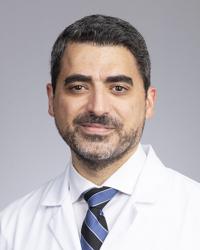Seasonal Affective Disorder: More Than Just the Winter Blues
November 23, 2023
Categories: Health & Wellness, Behavioral Health

As the days get shorter and the holidays approach, many people experience changes in their mood or energy level.
Usually, these changes are relatively mild and go away on their own. But sometimes, they can signify a more serious condition called seasonal affective disorder (SAD).
“Seasonal affective disorder is a type of depression that lasts four to five months and follows a seasonal pattern,” says Wesam ELRamahi, MD.
“Many people aren’t aware that seasonal affective disorder can occur in both winter and summer, though the winter form is more common.”
Here, Loyola Medicine family medicine specialist Dr. ELRamahi answers questions about this highly treatable condition:
What are the symptoms of winter depression vs. summer depression?
Winter and summer SAD have opposite symptoms. People with winter depression may experience:
- Sad mood
- Increased appetite, especially for carbohydrates and sugars
- Lack of interest in doing things you normally like to do
- Low energy
- Sleeping more than usual
- Weight gain
Symptoms of summer depression include:
- Difficulty sleeping
- Irritability
- Loss of appetite
- Restlessness and anxiety
- Weight loss
The symptoms of SAD can vary widely in severity. When severe, symptoms may affect your ability to function or include thoughts of suicide.
Who is at risk of seasonal affective disorder?
People with mental health conditions may be more likely to experience SAD. “If you have clinical depression, your symptoms may worsen seasonally,” says Dr. ELRamahi.
Other mental health conditions associated with SAD include:
- Alcoholism
- Anxiety
- Attention deficit hyperactivity disorder
- Bipolar disorder
- Eating disorders
- Panic disorder
Other factors may increase your risk of SAD, such as:
- Age of 18 to 30
- Female gender
- Having a family history of seasonal affective disorder
- Living in a northern latitude
How common is seasonal affective disorder?
Understanding how often SAD occurs is complex since people often do not seek care. Studies suggest winter seasonal affective disorder affects between 1% and 10% of people in the United States. Summer seasonal affective disorder is much less common.
What causes seasonal affective disorder?
Doctors aren’t sure exactly what causes SAD. It’s most likely related to a disruption in your body’s 24-hour cycle (circadian rhythm).
“Hormones called neurotransmitters, including serotonin, melatonin and dopamine, help regulate your mood and sleep,” says Dr. ELRamahi. “In seasonal affective disorder, neurotransmitter levels become unbalanced. This imbalance affects how you respond to light-dark changes, especially in the fall.”
The cause of summer SAD is less clear, but may be in part due to low vitamin D.
Genetic factors may also play a role in SAD by altering neurotransmitter function. Genetics may be particularly important since SAD runs in families.
What are the treatments for seasonal affective disorder?
Treatment options are similar for winter and summer SAD. “We have several effective forms of treatment,” says Dr. ELRamahi. “I often recommend more than one type to provide the greatest relief of symptoms.”
Treatments for seasonal affective disorder include:
SAD Light Therapy (Phototherapy)
Since changes in light trigger SAD, one type of treatment is to modify your light exposure.
If you have winter seasonal affective disorder, you may receive light therapy that simulates sunlight. During light therapy, you may sit in front of a special SAD lamp for 30-60 minutes per day starting around 7 am for one to two weeks.
If you still have symptoms, then light therapy can be added in the evening for up to 60 minutes per day for up to eight weeks. Lights are also available that simulate dawn, turning on gradually just before you wake up.
For summer seasonal affective disorder, treatment may involve limiting your exposure to daylight to no more than 13 hours per day. Staying cool, especially at nighttime, also tends to help, says Dr. ELRamahi.
Antidepressant therapy for SAD
Antidepressants are a mainstay of treatment for SAD. “The goal of antidepressant therapy is to stabilize neurotransmitter levels and regulate your circadian rhythms,” says Dr. ELRamahi.
When starting antidepressant therapy, it takes two to six weeks to become fully effective. Your doctor will monitor you carefully during this time for side effects. Let your doctor know if you have any concerning symptoms or thoughts of suicide.
As the season turns and your symptoms fade, your doctor may recommend tapering your antidepressants.
Cognitive behavioral therapy for SAD
Cognitive behavioral therapy (CBT) is a common psychological treatment for depression and anxiety that focuses on solving problems and challenges. Studies show that it can be as effective as light therapy. If your doctor recommends cognitive behavioral therapy, they will refer you to a therapist.
Lifestyle Changes that improve SAD
Exercise and proper nutrition can help improve your mood and lower stress. Being more active and eating a healthier diet can help reduce symptoms of SAD.
Should you treat seasonal affective disorder symptoms before they start?
If you’ve had SAD for several years, you may be able to anticipate your symptoms. Before symptoms occur, Dr. ELRamahi recommends starting phototherapy and exercising more.
You can also reach out to your doctor to refill your antidepressant prescription if you’ve taken antidepressants previously.
When should you talk to your doctor about seasonal affective disorder?
Many people experience SAD and never seek help. If your symptoms interfere with your daily activities, job, relationships or home life, talk to your doctor, says Dr. ELRamahi.
Treatment can make a big difference in your quality of life.
Family medicine care at Loyola Medicine
Loyola’s family medicine doctors provide lifelong care for patients of all ages. Our family medicine services include preventive care and management of chronic illnesses. We also prioritize early identification of mental health conditions and incorporate routine mental health screening into every visit.
At Loyola, you’ll find skilled, compassionate practitioners dedicated to your well-being. Using a shared decision-making approach, we work with you to help you achieve optimal health. You also have access to the vast resources of Loyola Medicine when you need specialty care.
Our family medicine offices are located throughout Chicago’s western and southwestern suburbs and are accepting new patients. To make an appointment, call 888-584-7888 or schedule an appointment online.
Wesam ELRamahi, MD, is a family medicine specialist at Loyola Medicine and is board certified in family medicine. Dr. ELRamahi earned his medical degree at the American University of the Caribbean School of Medicine and completed his residency at the University of Louisville School of Medicine.
Dr. ELRamahi focuses on open communication and active listening to understand the whole person, not just the disease process. He is an advocate for ensuring people of all backgrounds have access to high-quality, patient-centered care.
Book an appointment today to see a Loyola Medicine primary care provider by self-scheduling an in-person or virtual appointment using myLoyola.
